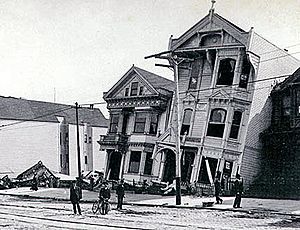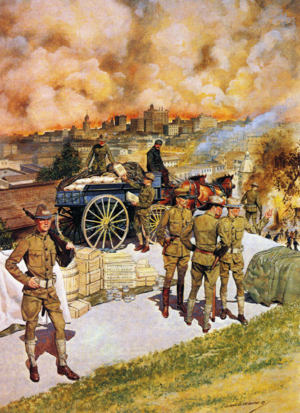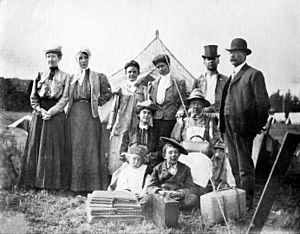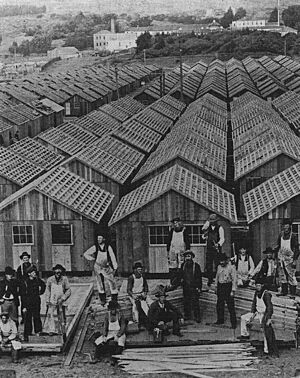1906 San Francisco earthquake facts for kids
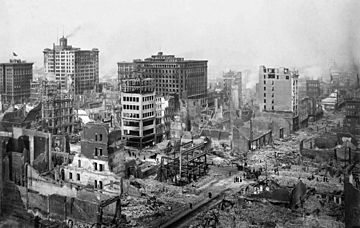 |
|
| UTC time | ?? |
|---|---|
| Magnitude | 7.8 Mw |
| Depth | 8 kilometers (5.0 mi) |
| Epicenter | 37°45′N 122°33′W / 37.75°N 122.55°W |
| Areas affected | United States (San Francisco Bay Area) |
| Max. intensity | X - Intense |
| Casualties | 3,000+ (Estimated 3425) |
The 1906 San Francisco earthquake was a very powerful earthquake that shook San Francisco, California, on April 18, 1906. It was so strong that people felt it far away, from Los Angeles to Oregon and Nevada. The earthquake measured about 7.8 on the Richter scale, which is a way to measure how strong an earthquake is.
Sadly, around 3,000 people lost their lives. Also, between 227,000 and 300,000 people lost their homes. This was a huge number of people, especially since San Francisco's population was about 410,000 at the time.
After the earthquake, many fires started. This happened because gas pipes broke, and the gas caught fire. The mayor thought that if some buildings were blown up with dynamite, it would stop the fires from spreading. But this idea didn't work, and the fires quickly spread through the city.
More than 80% of San Francisco was destroyed by the earthquake and the fires that followed. The city is built on the San Andreas Fault, which is a giant crack in the Earth's crust. The movement of this fault caused the earthquake. Some people took advantage of the chaos and stole things. Because of this, the Army had to come in to help keep the peace.
Contents
What Happened After the Earthquake?
How the Earthquake Affected People and Places
At first, officials reported 375 deaths. However, many deaths in Chinatown were not counted. Today, experts believe at least 3,000 people died. Most of these deaths happened in San Francisco. But 189 deaths were reported in other parts of the Bay Area. Nearby cities like Santa Rosa and San Jose were also badly damaged.
In Monterey County, the earthquake even changed the path of the Salinas River. Before, the river flowed into Monterey Bay near Moss Landing. After the quake, it moved 6 miles south.
Many people were left without homes. About half of them went across the bay to Oakland and Berkeley. Newspapers at the time said that places like Golden Gate Park and the Presidio were covered with temporary tents. Many of these camps were still being used more than two years later.
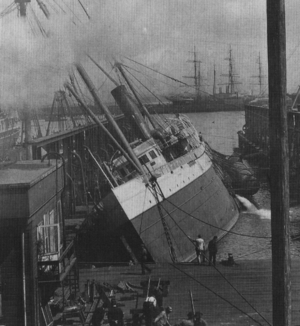
The earthquake and fires had a big impact on California's future. Before the disaster, San Francisco was the ninth-largest city in the United States. It was the biggest city on the West Coast. It was also a major center for money, trade, and culture. Over 80% of the city was destroyed.
Even though San Francisco rebuilt quickly, the disaster caused trade and people to move south to Los Angeles. Los Angeles then grew to become the largest city in the West.
Understanding the Earthquake's Strength
The earthquake's strength is usually measured as a moment magnitude (Mw) of 7.8. Some experts have suggested it might have been between 7.7 and 8.25. The main earthquake started about 2 miles (3 km) offshore, near Mussel Rock. People felt the shaking from Oregon all the way to Los Angeles, and as far inland as central Nevada.
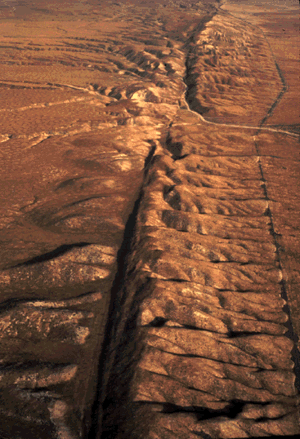
This earthquake happened because of a break in the San Andreas Fault. This fault is a huge crack in the Earth's surface. It marks the boundary between the Pacific Plate and the North American Plate. These two giant plates are always slowly moving past each other. During the 1906 earthquake, the fault broke for about 296 miles (476 km) both north and south. The ground moved as much as 20 feet (6 meters) in some places.
A smaller earthquake, called a foreshock, happened about 20 to 25 seconds before the main earthquake. The strong shaking of the main earthquake lasted about 42 seconds. The shaking was so intense in San Francisco that it was rated VIII on the Mercalli intensity scale. In areas like Santa Rosa, the destruction was even worse, rated IX.
The U.S. Army's Role
The city's fire chief was badly hurt when the earthquake hit and later died. The acting fire chief asked the Presidio, an army base, for dynamite. General Funston, an army leader, decided to send troops to help. He sent a message to Mayor Eugene Schmitz and then ordered soldiers from nearby Angel Island to come into the city. Explosives were brought across the bay.
In the first few days, soldiers helped a lot. They patrolled streets to stop people from stealing. They also guarded important buildings like the U.S. Mint and the post office. They helped the fire department use dynamite to tear down buildings. This was an attempt to create gaps to stop the fires from spreading.
The army also helped feed, shelter, and clothe the thousands of people who lost their homes. More than 4,000 troops helped during this emergency. By July 1, 1906, the city's government took over the relief efforts, and the army left.
Mayor Schmitz also gave an order that allowed soldiers and police to kill anyone caught stealing or committing other crimes. While some soldiers did steal, most of them helped the community greatly.
New Homes for Those Affected
The army built 5,610 small "relief houses" out of redwood and fir wood. These houses were for 20,000 people who had lost their homes. The houses were grouped into eleven camps. People could rent them for two dollars a month until they could rebuild their own homes. The houses were painted olive green, partly to blend in and partly because the army had a lot of that paint.
At their busiest, these camps housed 16,448 people. But by 1907, most people had moved out. The small houses were then used as garages or shops. Each house cost about $100 to build. The $2 monthly rent helped people eventually buy the house for $50. Most of these temporary homes are gone now, but a few still exist. The last official refugee camp closed on June 30, 1908.
Rebuilding San Francisco
The earthquake and fires caused more than $400 million in damage. This would be billions of dollars today.
Leaders in San Francisco tried to make the disaster seem less severe. They worried that if people knew the full extent of the damage, outside investors wouldn't want to help rebuild the city. California's governor, George C. Pardee, quickly said that San Francisco would be rebuilt fast. He didn't even mention the earthquake in his first public statement.
Rebuilding plans started almost immediately. Many banks were destroyed, so it took days for their fireproof vaults to cool down before they could be opened. However, the Bank of Italy had moved its money to safety. This allowed them to provide money right away. The bank's president also sent ships to bring lumber from other states to help with the first rebuilding efforts. The Bank of Italy later became known as Bank of America.
Many people were impressed by how quickly San Franciscans started to rebuild. The city's original street layout was kept. However, some new ideas were put into place, like wider streets and a subway under Market Street.
The earthquake also led to the growth of the Pacific Heights neighborhood. Many rich homes on Nob Hill were destroyed or dynamited to stop the fires. Wealthy people then looked for new land to the west, where it was cheaper and had better views. This helped Pacific Heights become a very wealthy area.
Reconstruction was very fast. By 1915, most of the city was rebuilt. This was just in time for the Panama-Pacific Exposition, a big fair that celebrated the city's recovery.
Every year since 1915, the city remembers the disaster. Survivors used to gather at Lotta's Fountain. This fountain in the city's financial district was a meeting point during the disaster. People went there to look for loved ones and share information.
Images for kids
-
Arnold Genthe's photograph, looking toward the fire on Sacramento Street
-
The Agassiz statue in front of the Zoology building (now building 420), Stanford University
See also
 In Spanish: Terremoto de San Francisco de 1906 para niños
In Spanish: Terremoto de San Francisco de 1906 para niños


